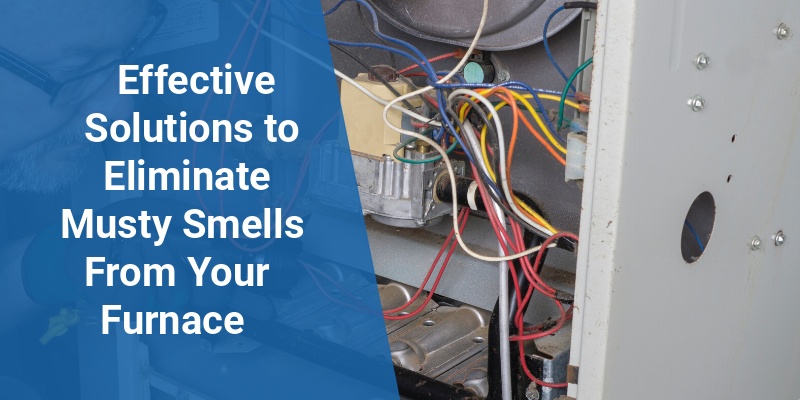A musty smell emanating from a furnace can indicate underlying issues that affect air quality and system efficiency. This odor is often caused by mold, mildew, dust accumulation, or moisture problems within the furnace or ductwork. Addressing musty smells promptly is critical for maintaining a healthy indoor environment and ensuring your heating system operates properly. This article explores common causes, detection methods, and practical solutions for ridding your furnace and home of unpleasant musty odors.
| Common Causes of Musty Furnace Smell | Solutions | Prevention Tips |
|---|---|---|
| Mold and Mildew Growth | Professional cleaning and mold remediation | Regular furnace and duct inspections |
| Accumulated Dust and Debris | Change or clean air filters frequently | Install high-quality air filters |
| Moisture and Condensation Issues | Inspect and repair duct leaks, improve ventilation | Maintain proper humidity levels indoors |
Identifying the Origin of Musty Smells in Furnaces
Pinpointing the source of a musty odor from your furnace is essential for effective remediation. Typically, the smell arises from mold or mildew growth within the furnace components or duct system, dust buildup, or trapped moisture. Other potential origins include clogged filters, blocked condensate drains, and poor ventilation.
Performing a thorough furnace inspection and air quality test can help homeowners and HVAC professionals determine if the smell comes from biological growth or mechanical issues. Visual checks inside air ducts and around the blower motor are particularly useful.
Common Causes of Musty Smells Linked to Furnaces
Mold and Mildew Development
Furnace systems, especially those with humidifier attachments or located in damp basements, can accumulate moisture that fosters mold and mildew growth. Mold spores then circulate with the heated air, creating a musty odor throughout living spaces.
Dust and Dirt Accumulation
Dust particles and debris that build up on furnace filters, blower fans, and duct interiors serve as a food source for microbes, resulting in bad smells. Neglected filters are a frequent cause of musty furnace odors.
Moisture and Condensation Problems
Inadequate ventilation or leaks in the furnace or ductwork can trap moisture and cause bacteria and fungi to proliferate. Condensation inside ducts can also generate persistent musty odors if not addressed.
Steps to Eliminate Musty Smells From Your Furnace
Replace or Clean Air Filters Regularly
Air filters collect dust, pet dander, and moisture, making them prime sources of unpleasant odors if left unmaintained. Changing HVAC filters at least every three months reduces odor-causing particles significantly. For severe odors, consider using filters with activated carbon or antimicrobial properties.
Call 888-906-9139 for Free Local HVAC Quotes – No Obligation, Just Savings!
Professional Duct Cleaning and Mold Remediation
Periodic professional cleaning removes mold growth and accumulated debris inside the ducts and furnace. In cases of persistent mold, professional remediation ensures spores are eradicated safely without contaminating indoor air.
Address Moisture and Ventilation Issues
Ensure the furnace area is dry and well-ventilated. Check and repair leaks in ductwork or around the furnace. Installing a dehumidifier in damp spaces can control humidity and inhibit microorganism growth responsible for musty odors.
Inspect and Maintain Furnace Components
Regular maintenance includes checking the blower motor, condensate drain, and drip pans for water buildup or blockages. Keeping these parts clean and dry minimizes chances of odor generation.
Preventative Measures to Avoid Musty Furnace Odors
- Schedule annual heating system maintenance through qualified HVAC technicians to detect and resolve issues early.
- Install high-efficiency air filters with antimicrobial coatings to reduce microbial accumulation.
- Maintain indoor humidity levels between 30% and 50% to prevent mold growth.
- Seal duct leaks to prevent moist air infiltration and ensure efficient airflow.
- Keep the furnace room and ducts clean and free of dust to minimize microbial growth sources.
Impact of Musty Furnace Smells on Indoor Air Quality and Health
Musty odors often indicate mold presence, which can release allergens and mycotoxins into the air. Exposure to these can cause respiratory irritation, allergic reactions, asthma exacerbations, and other health issues. Improving furnace conditions and eliminating musty smells significantly enhances indoor air quality and occupant wellbeing.
When to Call a Professional HVAC Technician
If a musty smell persists despite basic cleaning and filter replacement, it’s advisable to seek professional evaluation. HVAC experts have the tools to perform in-depth duct inspections, mold tests, and safe remediation. They also can repair moisture-related problems effectively.
Professional attention is critical for furnace longevity and maintaining a safe, odor-free living environment.
